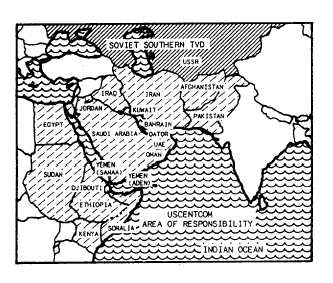Figure 1-4.-Middle East and Southwest
operation.
Asia area of
support when operating outside the range of land-
base aircraft. Second, logistics support is generally
supplied by their merchant fleet vice their navy.
Middle East and Southwest Asia
The Middle East and Southwest Asia (fig. 1-4)
area of operation includes northeast Africa, the
Arabian Peninsula, and the area of Asia bordering
the Persian Gulf.
The large geographic area of the region
provides for extremes of topography and climate.
It has mountains higher than 24,000 feet and
deserts below sea level. Temperatures range from
130°F or more to below freezing.
This region has many different cultural,
ethnic, and religious groups. At present six major
languages and hundreds of dialects are spoken in
that region. The region and people have a history
of conflict dating back to the Sumarians and the
ancient city of Ur in southern Babylonia (southern
Iraq).
CHOKE POINTS. —The Middle East and
Southwest Asia are the principal sources of oil for
the industrial countries. Located in the Persian
Gulf region is 55 percent of the world’s known
oil reserves. Oil from this area becomes more
important as the use of oil grows and the world’s
reserves decrease. Hostile countries could use the
Strait of Gibraltar or the Suez Canal as choke
points. That would disrupt international shipping
between the Mediterranean Sea and the Indian
Ocean or between the oil-rich gulf states and the
rest of the world.
About 10 percent of the world’s sea trade
passes through the Suez Canal at the choke point
of Babel Mandeb. Most of the Persian Gulf oil
passes through the choke point at the Strait of
Hormuz. Persian Gulf states are expanding
overland oil pipe routes to lessen the importance
of commerce through the Straits of Hormuz. The
overland oil pipes will connect to terminals out-
side the Persian Gulf.
POSSIBLE ADVERSARIES. —The United
States’ major goals in this region are to provide
stability and unrestricted seaborne commerce and
to ensure Western access to regional oil supplies.
The United States also has strong ties to Israel
and is committed to ensuring it remains strong
and independent.
Recent examples of the willingness of the
United States to commit assets to the region
include ship escorts from 1987 to 1988 during the
Iran-Iraq war. In August 1990 the United States
committed a substantial naval force to the area
in support of Operation Desert Shield and Desert
Storm. The goal of these operations was to deter
Iraq from attacking Saudi Arabia and to convince
Iraq to withdraw from Kuwait. Total force
commitment to Operation Desert Shield and
Desert Storm included 6 carrier battle groups and
450,000 combat personnel.
CONTROL OF SHIPPING. —U.S. naval
presence in the Middle East and Southwest Asia
includes the Sixth Fleet in the Mediterranean Sea,
naval units of the Sixth and Seventh Fleets in the
Indian Ocean and Persian Gulf, and U.S. Central
Command (USCENTCOM) forces. During peace-
time our forces in the Mediterranean consist of
1 or 2 aircraft carriers, with roughly 100 embarked
aircraft, or a battleship; supporting cruisers,
destroyers, and frigates; amphibious ships;
supply, fuel, and service ships; and nuclear sub-
marines.
The Sixth Fleet also includes a
2,000-member Marine Expeditionary Unit (special
operations capable). USCENTCOM naval forces
in the region, under Commander Middle East
Forces, routinely include a command ship and
four combatants. Additional forces available
for USCENTCOM include 5 Army divisions and
2 brigades; 1 Marine Expeditionary Force
(1 division and air wing); 21 Air Force tactical
fighter squadrons; B-52 bombers; 3 carrier
battle groups; 1 battleship surface action group;
and 5 maritime patrol aircraft squadrons.
1-8

